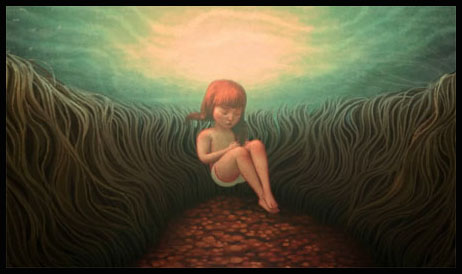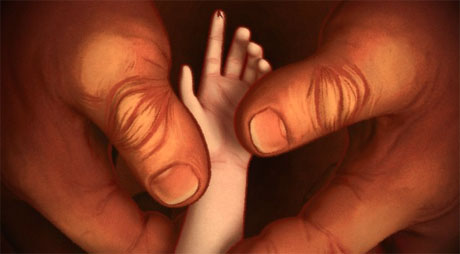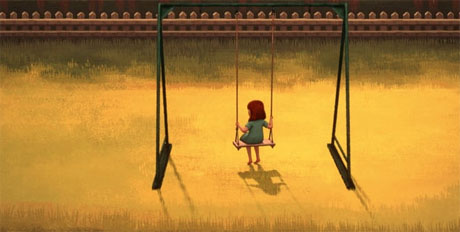
Director Stéphanie Clement’s Pachyderme is on the 96th Annual Academy Awards Best Animated Short Film shortlist. It’s about a woman named Louise who recalls visiting her grandparents as a child. What follows is a serious and shocking look at their time together. Clement provides some context for how Pachyderme came to be in this Animation Scoop Q&A. (This Email Interview was edited for length and clarity.)
Jackson Murphy: This is an intense story. What inspired you to make this animated short?
Stéphanie Clement: It all grew out from a shared interest for me and Marc Rius – scriptwriter and producer – to work together. We were seeking to tackle the delicate topic of incest. Based on psychological defense mechanisms such as repression and dissociation, we tried to build a story around an emotionally anesthetized character who struggles with their own memories.

Stéphanie Clement: As a student at Supinfocom Arles (now MopA), I was already looking for a way to use images to tackle the issue of intra-family violence. In Anonyme, a very short film I made during my third year, I portrayed a couple of automatons where, during a dance, the male partner gradually dismembers his companion. The film was a reaction to Hans Bellmer’s Dolls, a response to the deep unease I felt on discovering his work. I used it to broach the subject of coercive control in relationships. For my graduation film, Dans l’Ombre, I used the fairy tale Bluebeard to talk about assaults on minors. One of the key scenes in the film was the one in which a little girl lifts up her dress to reveal, instead of her legs, her four-poster bed. When I graduated school, I then continued with La Petite Vampire aux Crocs de Verre, a transmedia project that unfortunately didn’t come to fruition, but which dealt with family confinement with a background of abuse.
For Pachyderme, we opted for a narrative that was more rooted in the banality of everyday life – in Provence, the region in the south of France where Marc and I both come from – but at times allowing ourselves dreamlike escapes. An opportunity to use the power of images to express what is sometimes difficult to put into words.
JM: What were your goals in presenting Louise’s emotions?
SC: Louise is an unobtrusive, silent, overly well-behaved little girl, which is reflected by a frozen attitude, an inexpressive face and slow, withdrawn, tinged with hesitation, almost clumsy gestures. Her adult voice, almost monotone and disembodied, betrays the state of emotional anesthesia in which she is immersed. This is the fragmented, incomplete narrative of a woman who has repressed whole parts of her childhood. Some of her memories are clear and precise, while others remain nebulous. Pachyderme tackles a very delicate and painful subject, which we had to treat in a roundabout way, at the risk of alienating some part of the audience. By using dreamlike imagery and symbolism, I think the viewer is made more receptive. It may even touch them more deeply.

I sought to create images that would inspire in the viewer a mixed feeling of gentleness and unease. By introducing, for example, a sense of disquiet through framing and composition. The sky is virtually non-existent in the film. When the sky is present, it is obstructed by an element – the grandparents’ house, a tree, etc. – to evoke the character’s lack of escape. The little girl is a prisoner, trapped in a play of frame-within-a-frame, the outline of a door or a window. She is often fragmented in the shot, her upper body separated from her lower, as if dispossessed of herself. Sometimes, it’s her eyes that are cropped out, as the sign of a forbidden.
JM: Can you explain the animal eyes in the ceiling? It’s a powerful visual.
SC: In this sequence, what was repressed attempts to make its way to the surface. As Louise stares up at the “eyes” on the ceiling, her room is gradually invaded by the sound of wind in the foliage, the cracking of branches. The night sequence in the forest doesn’t appear until much later, but these two places are already colliding in Louise’s mind. Added to this is the fleeting vision of a face in the grooves of the wood, which disappears as soon as the first creaks of the wooden floor are heard.
JM: What went into creating the shading of colors and shadows in the backgrounds?
SC: I wanted to recapture the colors of the landscapes in the South of France, where I grew up: the yellow of the dry grass, the turquoise of the water, the dark green of the cypress trees and the orange-red of the “tomettes”, the small terracotta tiles typical of Provencal homes. The colors also had to evoke those of old photographs from the 1980s and 1990s, as if we were immersed in an album of family memories. The film begins in the tone of a simple, nostalgic film about childhood, colorful and bright. The palette then gradually evolves as the narrator’s awareness grows, ending on a pale, earthy note. This tonal shift is particularly pronounced in the reds. From the cheerful vermilion hues of the beginnings, they become deeper, garnet-red, with a few more sharp touches of crimson or scarlet during the night scenes, before abruptly fading, tending towards gray.

JM: What did you want to say about the impact of memories / our childhood?
SC: Through Louise’s story, the film speaks of childhood trauma that we struggle to acknowledge, but also of family denial, through the character of the grandmother. By gluing the big horn back together, she restores the grandfather’s image and imposes one version of the family narrative. It’s not until her disappearance that Louise’s traumatic memory can be released.
JM: What would becoming an Academy Award nominee mean to you?
SC: A nomination would represent an honor — a great recognition of the years of effort that went into making this film — but above all a formidable encouragement to continue my work, to persevere in my projects, present and future.
- INTERVIEW: Strap In For “Mars Express” - April 30, 2024
- INTERVIEW: Jeff Fowler On “Knuckles” And “Sonic 3” - April 22, 2024
- INTERVIEW: “Inside Out 2” Director And Producer On Pixar Sequel - April 16, 2024


 January 15th, 2024
January 15th, 2024  Jackson Murphy
Jackson Murphy  Posted in
Posted in  Tags:
Tags: 






